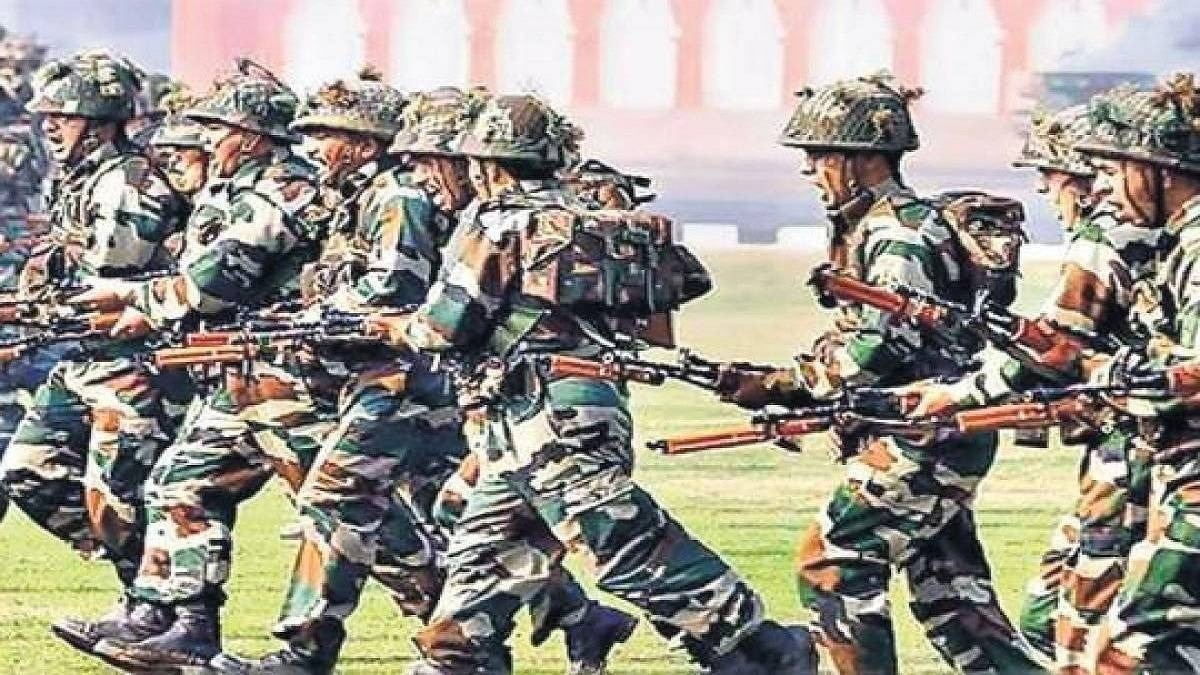Bagheera0084
SpeedLimited
- Jan 16, 2013
- 5,556
- 5,104
- Country of Origin

- Country of Residence

Border forces may recruit Agniveers, send them to Army, and take them back
Agnipath scheme was launched primarily to cut the expenditure on defence pension
By Brigadier P.K.G. Mishra (retd)
Issue Date: July 07, 2024
Updated: June 30, 2024 07:25 IST
Till two years ago, ‘Agnipath’ was the title of a poem by Harivansh Rai Bachchan, and of a film made famous by his son. Now it denotes a tour-of-duty scheme by which the armed forces recruit soldiers, and is listed as one of the many reasons that stopped the BJP from getting majority in the recent Lok Sabha elections. The Agnipath scheme, by which Agniveers are being inducted into the armed forces, was launched in 2022 primarily with an aim of reducing the expenditure on defence pension. At that point of time India had about 27 lakh ex-servicemen and seven lakh widows, making a total of about 34 lakh defence pensioners. With about 60,000 soldiers retiring every year, the figure today should be over 35 lakh. Soldiers, other than officers, retire between the age of 35 and 52 years depending on the rank they retire at. They retire after having served for 17 to 32 years. With the average life expectancy in India having gone up to around 70 years, an average retiree draws pension for more than 30 years. In other words, most of them are paid more when they are not working than when they were working. Hence, the government thought of reducing this annual financial outlay.
As per the new policy, a soldier serves initially for a non-pensionable four-year period. Thereafter, 25 per cent of them remain to serve for a pensionable service period; the rest, all in their early 20s, are sent home with no pension. A few could be absorbed in government departments, PSUs and private sectors. There was a proposal to induct some of them in the Central Armed Police Forces (CAPF) but they have objected saying their role is different from that of the armed forces, and that they cannot absorb military-rejects.
In short, there is no clear policy in place to absorb the 75 per cent. This has become a political issue, especially in states that are high recruiting grounds. Therefore, the government is now trying to review this policy.
A new proposal, said to have come from the Army, suggests two changes. One, Agniveers be recruited initially for six or seven years instead of four. Then, instead of 25 per cent being retained in service, keep 50 per cent. This would also entail automatic increase in the severance benefits.
This is only a knee-jerk response, which does not address the core issue which is that the youth want permanent jobs and the government wants to cut permanent jobs which are pensionable. Any solution should meet these two contradictory requirements.
Let’s first examine the promotion system in the Army. The Army can promote only 56 per cent of its sepoys, the lowest rank, to the next rank of naik. This means 44 per cent of recruits (about five lakh) retire at the age of 35 to 40, at the lowest rank of sepoy, after serving 17 to 19 years. These men would have to be paid pension for an average of 35 more years. Can we give these five lakh soldiers some permanent, pensionable jobs, without adding to the budgetary allocation for pension?
The CAPF, one million strong, are two types―one guarding the borders and the other taking care of internal security. Among the first are the Assam Rifles, the ITBP, the BSF and the SSB. They number about five lakh. Among the latter are the CRPF, the CISF and the NSG. They are also about five lakh. Some of these border guarding forces, such as the Assam Rifles, operate under the overall command of the Army permanently; others like the BSF come under the Army during operations. The upper age of their recruitment is higher by four to five years than that of the Army.
The solution is simple. The border guarding CAPF can recruit five lakh boys of 17-to-20 years age, give them over to the Army, where they can be trained for six months and asked to serve for four years. After the four years of service in Army, they can be reverted to their parent CAPF, after undergoing a refresher training, where they can serve till 60.
For his initial period with armed forces as Agniveer he will be paid a fixed monthly stipend, and his normal government salary will commence only once he joins his parent CAPF service. Even though the individual will be paid a monthly stipend, he will remain a Central government employee and will be entitled for all the terminal benefits of a normal soldier in case of any mishap. The advantages of this modified scheme are:
• Major reduction in sanctioned manpower of armed forces.
• Assured promotion (minimum one) to all the armed forces personnel’s before superannuation.
• More than 50 per cent of Army strength will be permanent as hitherto fore ensuring regimentation.
• Agniveers on reversion to CAPF will facilitate better operational affiliation with the Army.
• Major saving, not only in the pension allocation but even while in service, since during the period of engagement the Agniveer will be paid a monthly stipend only. In addition, no lump sum money will have be paid to anyone on exit after four years, as no one will be exiting in this model.
• CAPF will be getting operational trained manpower of its own and not any rejected lot from the armed forces.
• Hundred per cent get absorbed unlike the present 25 per cent; all will go on to serve till the age of 60.
• The government saves on salary and pension.
Mishra, a strategic affairs expert, serves as officer on special duty to the lieutenant governor of Delhi.
Agnipath scheme was launched primarily to cut the expenditure on defence pension
By Brigadier P.K.G. Mishra (retd)
Issue Date: July 07, 2024
Updated: June 30, 2024 07:25 IST
Till two years ago, ‘Agnipath’ was the title of a poem by Harivansh Rai Bachchan, and of a film made famous by his son. Now it denotes a tour-of-duty scheme by which the armed forces recruit soldiers, and is listed as one of the many reasons that stopped the BJP from getting majority in the recent Lok Sabha elections. The Agnipath scheme, by which Agniveers are being inducted into the armed forces, was launched in 2022 primarily with an aim of reducing the expenditure on defence pension. At that point of time India had about 27 lakh ex-servicemen and seven lakh widows, making a total of about 34 lakh defence pensioners. With about 60,000 soldiers retiring every year, the figure today should be over 35 lakh. Soldiers, other than officers, retire between the age of 35 and 52 years depending on the rank they retire at. They retire after having served for 17 to 32 years. With the average life expectancy in India having gone up to around 70 years, an average retiree draws pension for more than 30 years. In other words, most of them are paid more when they are not working than when they were working. Hence, the government thought of reducing this annual financial outlay.
As per the new policy, a soldier serves initially for a non-pensionable four-year period. Thereafter, 25 per cent of them remain to serve for a pensionable service period; the rest, all in their early 20s, are sent home with no pension. A few could be absorbed in government departments, PSUs and private sectors. There was a proposal to induct some of them in the Central Armed Police Forces (CAPF) but they have objected saying their role is different from that of the armed forces, and that they cannot absorb military-rejects.
In short, there is no clear policy in place to absorb the 75 per cent. This has become a political issue, especially in states that are high recruiting grounds. Therefore, the government is now trying to review this policy.
A new proposal, said to have come from the Army, suggests two changes. One, Agniveers be recruited initially for six or seven years instead of four. Then, instead of 25 per cent being retained in service, keep 50 per cent. This would also entail automatic increase in the severance benefits.
This is only a knee-jerk response, which does not address the core issue which is that the youth want permanent jobs and the government wants to cut permanent jobs which are pensionable. Any solution should meet these two contradictory requirements.
Let’s first examine the promotion system in the Army. The Army can promote only 56 per cent of its sepoys, the lowest rank, to the next rank of naik. This means 44 per cent of recruits (about five lakh) retire at the age of 35 to 40, at the lowest rank of sepoy, after serving 17 to 19 years. These men would have to be paid pension for an average of 35 more years. Can we give these five lakh soldiers some permanent, pensionable jobs, without adding to the budgetary allocation for pension?
The CAPF, one million strong, are two types―one guarding the borders and the other taking care of internal security. Among the first are the Assam Rifles, the ITBP, the BSF and the SSB. They number about five lakh. Among the latter are the CRPF, the CISF and the NSG. They are also about five lakh. Some of these border guarding forces, such as the Assam Rifles, operate under the overall command of the Army permanently; others like the BSF come under the Army during operations. The upper age of their recruitment is higher by four to five years than that of the Army.
The solution is simple. The border guarding CAPF can recruit five lakh boys of 17-to-20 years age, give them over to the Army, where they can be trained for six months and asked to serve for four years. After the four years of service in Army, they can be reverted to their parent CAPF, after undergoing a refresher training, where they can serve till 60.
For his initial period with armed forces as Agniveer he will be paid a fixed monthly stipend, and his normal government salary will commence only once he joins his parent CAPF service. Even though the individual will be paid a monthly stipend, he will remain a Central government employee and will be entitled for all the terminal benefits of a normal soldier in case of any mishap. The advantages of this modified scheme are:
• Major reduction in sanctioned manpower of armed forces.
• Assured promotion (minimum one) to all the armed forces personnel’s before superannuation.
• More than 50 per cent of Army strength will be permanent as hitherto fore ensuring regimentation.
• Agniveers on reversion to CAPF will facilitate better operational affiliation with the Army.
• Major saving, not only in the pension allocation but even while in service, since during the period of engagement the Agniveer will be paid a monthly stipend only. In addition, no lump sum money will have be paid to anyone on exit after four years, as no one will be exiting in this model.
• CAPF will be getting operational trained manpower of its own and not any rejected lot from the armed forces.
• Hundred per cent get absorbed unlike the present 25 per cent; all will go on to serve till the age of 60.
• The government saves on salary and pension.
Mishra, a strategic affairs expert, serves as officer on special duty to the lieutenant governor of Delhi.




